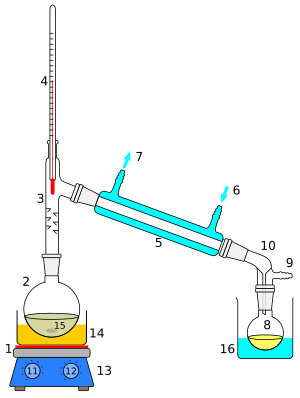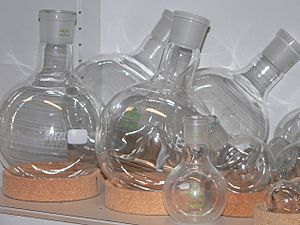Round-bottom flask facts for kids

Round-bottom flasks are a type of glass container used in science laboratories. They get their name because they have a round, spherical bottom instead of a flat one. Scientists and students use them a lot in chemistry and biochemistry experiments.
These flasks are usually made from a special type of glass called borosilicate glass. This glass is very strong and can handle high temperatures without breaking. This is important because many experiments involve heating liquids. Each flask has at least one tube-like part called a neck with an opening at the top. Some flasks even have two or three necks, which allows for more equipment to be connected at once. You can find round-bottom flasks in many different sizes, from very small to very large.
What Are Round-Bottom Flasks Used For?
Round-bottom flasks are super useful in a lab! Their unique shape makes them perfect for several important tasks:
- Heating liquids: Because of their round bottom, they can be heated evenly. This is great for boiling liquids or making chemical reactions happen at high temperatures. They can be placed directly on a heating mantle (a special heater that fits the round shape) or in a heating bath.
- Mixing chemicals: The round shape helps liquids swirl and mix easily. This is helpful when you need to stir or shake chemicals together to create a new substance.
- Distillation: This is a process used to separate liquids based on their boiling points. Round-bottom flasks are often used as the main container where a liquid is heated until it turns into a gas, which is then cooled back into a liquid in another flask.
- Storing chemicals: While not their main use, they can also be used to temporarily hold liquids or solutions.
Why Are They Round?
You might wonder why these flasks aren't flat at the bottom like a regular bottle. The round shape has some big advantages:
- Even heating: When you heat a liquid in a round-bottom flask, the heat spreads out evenly across the entire bottom surface. This prevents hot spots that could cause the glass to crack or the liquid to boil too quickly and dangerously.
- Strength: A spherical shape is very strong and can withstand changes in pressure, like when liquids are heated and cooled. This makes them safer for experiments.
- No corners: Without corners, it's easier to stir and mix liquids thoroughly. It also means there are no places for solid materials to get stuck, making them easier to clean.
How Are They Made?
Most round-bottom flasks are made from borosilicate glass. This type of glass is known for being very resistant to heat and chemicals. It's the same kind of glass used in many heat-resistant cooking dishes you might have at home.
The process of making them involves heating the glass until it's soft enough to be shaped. Skilled glassblowers or special machines then form the glass into the familiar round shape with one or more necks. After shaping, the glass is slowly cooled down in a controlled way to make sure it's strong and doesn't crack.
See also
 In Spanish: Balón de destilación para niños
In Spanish: Balón de destilación para niños


